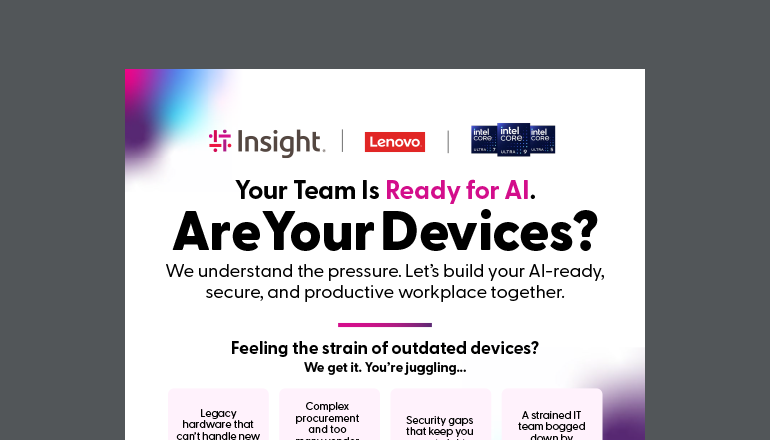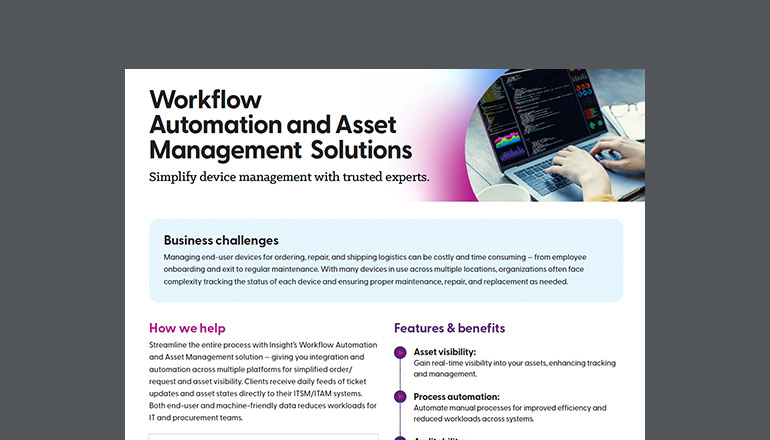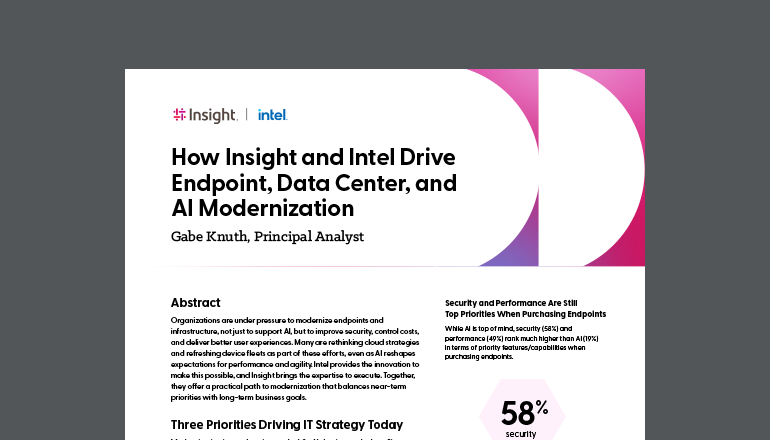Article 4 Reasons Why You Need an End User Device Management Policy
By Insight Editor / 31 Jul 2017 / Topics: Devices

Modern Businesses Need Modern Techniques to Tackle End User Device Management
Very few businesses — if any — can run today without a great deal of help from devices of all sorts.
Big data, Internet of Things (IoT), and business analytics. Each of these concepts — and many others — are reliant on an ever-expanding network of interconnected devices with new applications that are constantly in development and constantly changing.
What is an End User Device?
An end user device is a technical term referring to IT hardware that your employees — or simply people in general — use during work, in off-hours, for leisure and any other purpose.
Types of End User Devices:
End-user devices include, among others:
- smartphones
- tablets
- wearables
- smartphones
- desktops
- laptops
- workstations
Why End Users Matter
It’s a straightforward concept, but understanding it is important when it comes to cybersecurity.
When it comes to cyber threats, some view the end user — i.e. the person using a smartphone for work or office computer — as a major vulnerability, if not the biggest vulnerability.
This is because some cyber threats are squarely aimed at exploiting the end user’s lack of insight about the security threats they face or how to stop them.
External Attacks
A notable example of this problem is in ‘spear phishing’ attacks. These attacks are email-based and attempt to fool the end-user, such as an employee, into thinking they are legitimate.
The goal is to have the end-user provide something they normally wouldn’t to a stranger, much less a hacker. However, because they were fooled into thinking the email was legitimate, they’ll provide that thing, such as money, information, or opening a virus.
In this situation, the external attacker compromised your system by exploiting your end user.
Insider Threats
External attacks are only one side of the coin. The other is that of internal or insider threats where you deal with malicious insiders.
Unless you have access controls in place to manage access to your applications or data, then the wrong end user in your company could have access to those critical assets.
For example, access to confidential client information shouldn’t be available to a contractor who’s using their phone on your network. However, with such lax controls, you’ve made information theft — including data leaks, theft of intellectual property, and loss of client information — very easy.
Alternatively, your end user might not be malicious, but a victim of circumstance. If they lose their phone or computer, then unless and until those devices are reclaimed, those lost devices could be exploited to gain access to your data.
Finally, end users aren’t necessarily tied to just devices, but applications, virtual desktops, and other critical business elements that aren’t hardware based. This is where "end user computing" (EUC) has emerged as a broader concept for managing end users.
Being able to stop malicious insiders from accessing sensitive information, remote-wiping lost and stolen devices, and removing access from ex-employee devices all fall under the domain of end user device management.
What is End User Device Management?
End-user device management is necessary to protect your business data and network.
Management of end-user devices includes installing and updating operating systems and application patches, managing user accounts, and maintaining up-to-date security.
As such, having an end user device management plan coupled with comprehensive endpoint services will go a long way to helping your business excel.
A company is only as good as the tools it uses to stay productive. With that in mind, you need to have a strong strategy in place to ensure that your end-user device management plan keeps your employees and your business safe from cyber threats.
Big companies have taken notice of how important a need this is, with Microsoft Enterprise Mobility + Security (Microsoft EMS) being a leading player on the market.
4 Reasons Why You Need an End User Device Management Policy
Let’s take a look at four ways that having an end user device management plan will help your business not only survive but thrive in the modern technology landscape.
1. Security
The online world has never been more vulnerable than it is today.
With two massive malware attacks occurring in the past few months — infecting tens of thousands of computers — companies need to have solid security plans in place to ensure that they’re protected against such incursions.
Endpoint services play a big role in the mitigation of security risks by bolstering your cybersecurity in several key ways. This is one of the key focuses of Microsoft EMS, as well as other mobility management solutions.
First, centralized management systems can be put in place to keep track of your employee profiles, policies, and devices. You gain a wealth of information, which is available to you at all times should you need to adjust your security service on the fly.
Another key way that end-user device management policies protect your data is through the establishment and enforcement of company policies. These dictate how a device can be used safely by employees, and can be implemented into the admin panel.
After all, many breaches are a result of a lack of diligence on an employee’s part rather than a failing of technology. These management systems can also set device boundaries and access barriers to help mitigate human risk.
Finally, these services can also help you easily access profiles to wipe sensitive data in the case of lost or corrupted devices. This not only helps maintain data privacy but can also counteract any data blackmail or ransom that would take place in the event of a successful malware attack.
2. Increased efficiency
In any business, efficiency is the name of the game. Being able to get the most out of your time, money and resources is key to running a successful enterprise.
End user device management services help you establish a more efficient business by bringing experts in to do the heavy lifting.
Instead of concerning yourself with the specifics of every new device and application — which can change or be replaced at a head-spinning pace — experts cater to that aspect of your company and free you to focus on your business’s actual products and services.
And of course, the more efficient and effective a company is, the better the bottom line is going to be.
3. Cost Savings
Speaking of the bottom line, IT spending in the modern era can add up if you’re not careful. Keeping costs down is not an easy endeavor, and the finding good IT help without breaking the bank is a difficult balancing act.
With managed services, you can reduce your IT investment by bringing in a cost-effective team of experts to reduce your reliance on IT support in-house. This team also relieves your internal IT managers to focus their attention on other areas of the business, thus increasing output across the board while saving money.
4. Endpoint Services Can Modernize Your Business
As mentioned above, having the latest technology working at the most optimal level is one of the greatest competitive advantages a company can have in our technologically demanding world.
But finding the latest and greatest technology today can be, at times, a nightmare for those without an in-depth knowledge of the landscape.
With so many devices and applications promising to provide lofty improvements, it can be daunting to sort through options and settle on a particular device or set of devices.
And that’s where endpoint services and service providers come in. They not only help you identify the best devices to power your business but also determine which ones form the best cohesive whole together.
Conclusion
To borrow an example from the mundane, trying to get a Mac and a PC to work together — depending on the program — can be a real headache. Endpoint services help you avoid those needless roadblocks by ensuring cohesion and compatibility between devices and applications.
At Insight, we pride ourselves at being a premier end user device management service provider with the knowledge and expertise necessary to help you power your business. We can help you achieve better operational efficiency, save money, establish better security protocols, and modernize your business.





